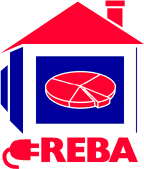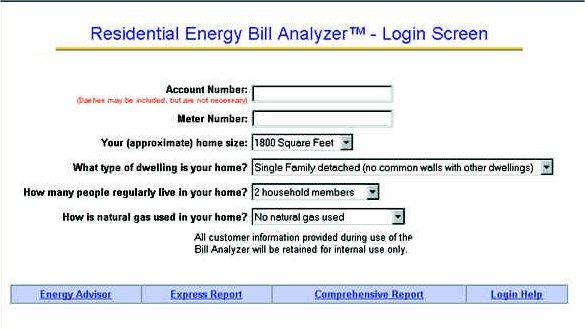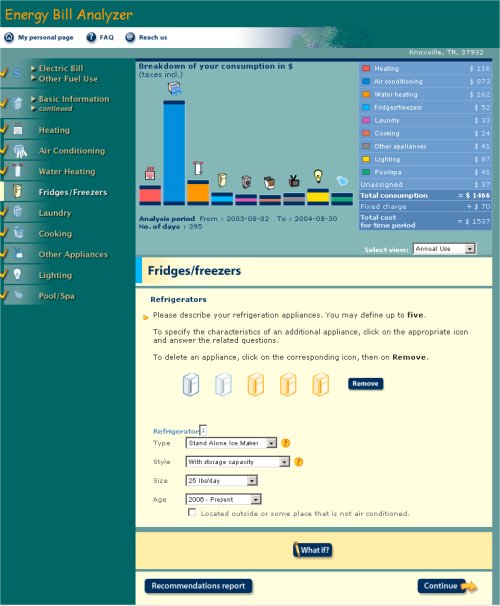
 |
The Residential Energy Bill Analyzer |
The Residential Energy Bill Analyzer (REBA) by AccuStat® is a collection of software tools that enables utility customers to view and analyze energy consumption and cost. REBA was designed to help customers understand their energy consumption in terms of end-use costs, identify cost-effective energy savings investment opportunities, and monitor the performance of past energy-saving measures and building usage changes. The REBA suite of applications provides access to recent and historical energy consumption information, helps the end user identify trends and the potential for savings, and permits evaluation of different utility rate structures including schedules based on time of use.
In calculating energy costs hourly weather data is used for hourly simulations to compute end use loads. A thermal load analysis (PRISM) is utilized when sufficient billing data is available. Final thermal load estimates are computed as the weighted average of both the statistical and engineering estimates. This approach provides the utility customer and utility customer service personnel with the ability to understand impacts of local weather changes. All of the end use costs are calculated on a billing level basis. These estimates are reconciled on a billing use level for a specified confidence range to reduce unexplained consumption.
REBA also makes possible general "what if" analysis of usage patterns and cost impacts, without changing the billing level basis. Cross effects in changes to internal loads arer also included in the reports. REBA provides a variety of tools to assist utilities in strengthening energy conservation programs, as well as expand customer service and marketing/retention programs. The REBA software is available in Spanish and French.
How REBA Works
REBA automatically performs a thermal load analysis when the customer's billing data is first entered - either through interfacing with a utility's customer billing system or through manual entry by the user. Comparing energy usage with weather data for the utility's service area, this analysis separates total energy consumption into three end-use categories - heating, cooling, and base (all other uses). REBA then generates an Express Report displaying
These analyses can be refined by participating in REBA's energy audit. The customer can answer some or all of the energy audit questions for a more detailed breakdown of energy usage. REBA then generates a Comprehensive Report that shows energy usage broken down even further, as well as specific recommendations for reducing energy usage, with links to additional information.

REBA System Components
REBA';s components include
REBAServletTM: This application, the original REBA component, is an Internet-based tool for examining and understanding residential energy expenditures. This program is primarily intended as a tool for residential customers with Internet access and utility phone representatives and field auditors. REBAServlet is a 100% Java so that it can be run on a wide variety of server platforms to provide users a personalized energy use report in both HTML and PDF formats. REBA uses an object-relational database package that can be used with all popular database engines. REBA can be configured to work with other applications that provide user authenication or as a stand alone web application that provides secure password protection.

REBA can be offered as a password-protected service over the Internet.
REBAServlet can also be configured as a stand alone tool for usage by field auditors. Intended to help utilities improve servicing of residential customers, this application offers distinct demand-side management benefits.
REBAMailTM. This REBA application is designed for batch processing of energy usage surveys. This survey processor is ideal for processing mail-in surveys. This component reads weather and billing data along with customer survey responses from a local text file or database. The application is configured to handle that surveys that are electronically scanned and saved in an XML format. REBAMail generates a personalized report in a PDF with either black and white or color images that can be printed on specially-designed utility forms

The energy audit function helps to refine analysis of energy use patterns and costs.
Unlimited Flexibility and Customization
Because of its Model, View, Controller (MCV) structure, REBA can be configured to meet virtually any requirements dictated by a utility's information system or customer service/marketing needs. In addition, REBA's utilization of XML templates offers utilities unlimited potential for customization. Whether it is the "look and feel" of individual screens or the content of customer reports, the REBA software system can be set up and customized to reflect a utility's corporate image and overall customer service/marketing objectives. For example, REBA can be easily configured to allow qualified customers to sign up services offered by the utility or affiliated partners.

REBA's Comprehensive Report presents specific areas for improved energy performance, along with links to additional information.
All survey and report text, as well as recommendation logic, is contained in database tables to help minimize maintence efforts and provide the flexibility to easily update report content. A web based uility called the Codebook Manager is used to create and update all survey and report content.
Helping Utilities Retain the Competitive Edge
With deregulation bringing increased competition for customers, utilities will need to use every resource at their disposal to retain current customers and attract new ones. REBA can serve as the foundation for an effective customer service/marketing program, giving utilities that winning edge.
To learn more about REBA, or to see the possibilities offered by an interactive customer information program, contact AccuStat today.